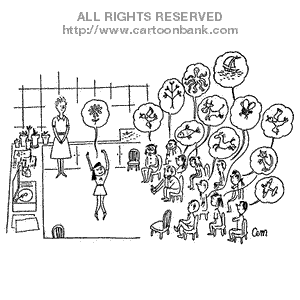
One of my professors presented this New Yorker cartoon in his lecture. It’s *brilliant*. What does it mean to present an abstract representation of an idea and have others “read” that idea? When does conveying something work and when does it not? What are the implications of such?
i was at a conference recently where a fellow gave a superb talk. later, we had lunch together and he told me that he believes his job is to communicate ideas. others might perceive his job as “researcher” or “computer scientist”. and he is these things. but in his mind, these titles are meaningless if he cannot communicate his findings to others. and so his primary (albeit silent) title is “communicator”. and he works very hard to communicate to his audience precisely what he means. i took that to heart and have been masticating that one ever since. successfully verbally and bodily communicating an abstract notion to a group is hard work.
Well, I discovered your blog a couple weeks ago, but never planned on commenting. However, this cartoon was too appropriate to pass up. As a modern dancer, I live this cartoon every day. Modern dance is abstract and aims to provoke a response rather than simply entertain (like ballet). We are constantly presenting ideas in such a way that they will most likely be interpreted in many. This is always a risk but also always an appeal because an idea may be born that did not occur to the artist. This idea now has a life as well. Anyhoo, I loved this cartoon and I enjoy your site very much. Thank you.
its funny cause your post about it is a little abstract as well.
As an artist I’ve gotten myself weary of attempting to herd the thoughts of the audience. My reasoning: yeah I’m the artist but so what, Are you expecting some kind of great truth?
then I go to the logic that maybe the best anyone can ever do is to try relating/expressing their own experience, and maybe achieve some understanding in the process.
But if we are using ideas as a commodity inteded to speak to a mass, than we need to use some kind of common language.
to me abstraction is supposed to be more about the feeling of an something rather than an idea about somthing.
even though I speak english, I can not have a complete idea what it means to say ‘One of my professors presented this..in his lecture’ even if I have met other professors and been to other lectures I can only try to assimulate my experience of those terms with your expression of them.
what if we used cartography as a metaphor?
to steal an idea from borges, what is the ideal size for a map?
One that is to scale, though more accurate, is supperfluos.
i’m an art major in minnesota and i’m totally going to present this cartoon to my 3d design teacher. this guy is on us and on us to think abstractly and blah blah blah, but it’s annoying because i am thinking abstractly, it’s just not the way he wants so he tells me to change. being an artist to me is about expressing my values and views on things, and letting people interpret them for themselves. yes, if i’m making an important commentary on a social issue, which i usually am, i want the point to come across, and thats my job to make it understood. contrary to that though, if i’m making a piece of art to express my sadness, or anger, or frustration, or love, who cares what other people get from it, as long as it’s beautiful and touches them. thank you for this cartoon,,,,i’m going to blow it up and paste it to the bulletin in the design lab.
i use your site for ani lyrics all the time, as they are incorporated in many of my works. look for me at the minneapolis glbt young artists exhibit in spring!
“ya see what ya wanta see, and ya hear what ya wanta hear”
–harry nilson, the point
The dancer is not communicating her idea, but rather providing a mechanism through which the audience are discovering their own ground or context. Meaning occurs when figure rubs against ground (using Marshall McLuhan’s language). Hence, change the ground, by which I mean any aspect of the total context of the recipient, and you achieve new meaning – a meaning that is necessarily unique to the individual.
In this case, as in the case of most communication, “the receiver is received” (paraphrasing McLuhan who used to say that with electrically-mediated communications, the sender is sent.) We “receive our own context or ground; in synchronous, full-presence communication (eg. a face-to-face conversation) it is relatively common to synchronize contexts (although it often takes some doing.) In asynchronous, heavily mediated conversations, it is relatively difficult to either accomplish, or to recognize the need to do so. That is why so many emails, postings, and so forth are misunderstood.
A great cartoon, though, and perfect for understanding the issue of non-commonality of ground!